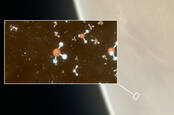This article is more than 1 year old
Remember life on Venus? One of the telescopes had 'an undesirable side effect' that could kill off the whole idea
Alas, it looks as though, for now, us humans are still alone in the pitch-black depths of space
The notion of phosphine-producing microbes floating in Venus’s atmosphere is looking more and more shaky, as scientists believe the detection of the gas may have been skewed by the antenna of a telescope used to discover it.
Last year, the astronomy community was buzzing with excitement that alien life may exist right under our noses on the Earth’s closest neighboring planet: Venus. A team of researchers led by the University of Cardiff in the UK announced they had detected a whiff of phosphine in the planet’s clouds. On Earth, the toxic gas is made by microorganisms in oxygen-starved environments, such as pond slime. Is it possible this gas was also being made by microbes on Venus, everyone wondered.
Here's what had happened to reach that point: in 2017, scientists pointed the James Clerk Maxwell Telescope (JCMT) in Hawaii at Venus to detect background radio emissions from the planet. They noticed emissions with a frequency of 266.94 GHz were being absorbed – and it was known that phosphine and sulfur dioxide absorb signals near these radio frequencies. It’s difficult to differentiate between these two substances, though, and so in 2019, the Atacama Large Millimeter/submillimeter Array (ALMA) in Chile was powered up to investigate as well. From these findings, the astronomers last year ruled out sulfur dioxide and concluded they had found signs of phosphine.
Now a team led by the University of Washington in America reckons that, rather than picking up phosphine, the array's antenna was actually detecting sulfur dioxide – which isn't considered evidence of life and is abundant in Venus's atmosphere. The US group is due to publish a paper in Astrophysical Journal Letters laying out their thinking.
“The antenna configuration of ALMA at the time of the 2019 observations has an undesirable side effect: the signals from gases that can be found nearly everywhere in Venus’s atmosphere – like sulfur dioxide – give off weaker signals than gases distributed over a smaller scale,” said Alex Akins, co-author of this latest paper and a researcher at NASA’s Jet Propulsion Laboratory.
In short, the UK team probably mistook sulfur dioxide for phosphine. The US scientists also pulled together various datasets of Venus to build a model to simulate its atmosphere to see whether the Cardiff group's readings could be produced if the clouds were made up of sulfur dioxide and not phosphine. And yes, SO2 would result in the same level of absorption.
“The radiative transfer (SMART) model is a model that looks at the interaction of electromagnetic radiation with molecules and aerosols in a planetary atmosphere, and it can be used to simulate planetary spectra, given atmospheric composition,” Akins told El Reg on Friday.
“We used this model to simulate Venus spectra in the frequency range observed by the JCMT and ALMA telescopes. Using the radiative transfer model we were able to conclusively show that the JCMT feature at 266.94 GHz would have been produced in the atmosphere above the Venus clouds, not in the Venus clouds. Using this model we showed that typical amounts of sulfur dioxide in the upper atmosphere of Venus could explain the 266.94 GHz feature, without the need for phosphine.”
The Register has asked the team behind the phosphine discovery for comment. No one was available to talk.
The scientific method
The jury is still out on whether phosphine really exists in the concentrations reported last year. Although low, the levels were high enough to suggest some other process was producing the phosphine, possibly microorganisms.
But in the past few months, scientists working independently have published papers casting doubt that phosphine had been detected at all.

Howdy, er, neighbor – mind if we join you? Potential sign of life spotted in Venus's atmosphere
READ MORE“If the JCMT signal were from phosphine in the mesosphere, then to account for the strength of the signal and the compound’s sub-second lifetime at that altitude, phosphine would have to be delivered to the mesosphere at about 100 times the rate that oxygen is pumped into Earth’s atmosphere by photosynthesis,” said Victoria Meadows, co-author of the Washington paper and professor of astronomy at the university.
To answer the question once and for all, scientists need to send a probe to Venus to directly sample the chemical composition of its atmosphere.
“There may be phosphine in Venus’s atmosphere,” Akins told us. "The real question is how much phosphine there is, if any. The exciting part about the original claim was that the amount of phosphine detected was beyond what could be explained by our current understanding of Venus’s atmospheric chemistry, hence the need for something else like life to generate that much of it.
“Our interpretation of the observations is that this much phosphine isn’t present at Venus. If phosphine is present in Venus’s atmosphere, there would be far less of it, which wouldn’t be nearly as exciting.” ®
